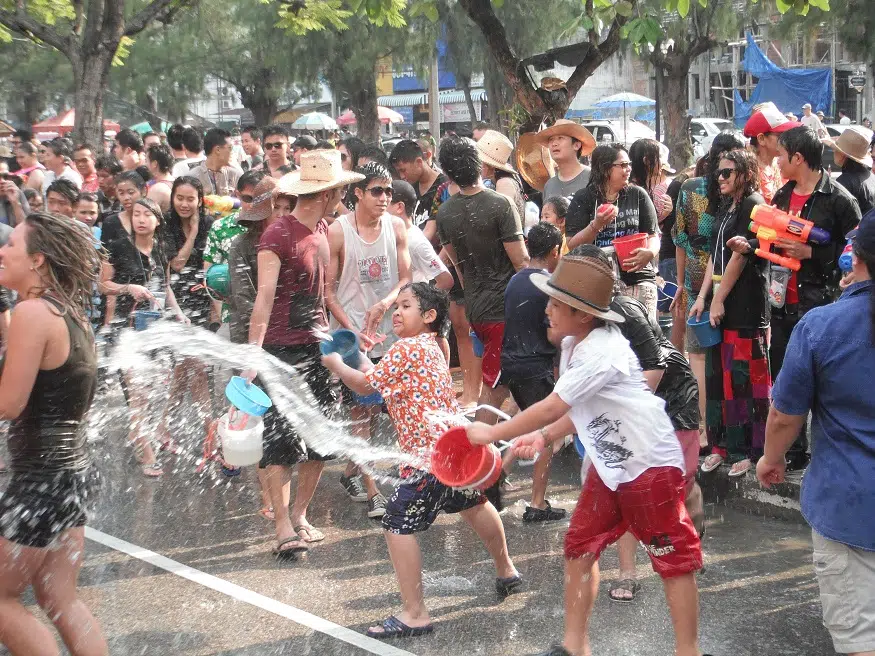Songkran is Thailand’s most famous festival, but calling it a water fight doesn’t come close to capturing its full meaning. What begins as a New Year tradition of cleansing and renewal quickly transforms into something far more energetic and unforgettable. The celebration takes over entire cities, small villages, and even quiet temples, turning streets into playgrounds and strangers into companions.
Travelers drawn in by the festival’s fun often leave with a deeper appreciation for the cultural roots behind the chaos. While most expect a few splashes and friendly laughter, the scale and intensity surprise many who experience it for the first time. The experience in Thailand is equal parts cultural immersion and sensory overload.
A Festival Rooted in Ritual
Songkran in Thailand begins with customs that reflect deep respect for family and tradition. Many people return to their hometowns to visit elders, clean family homes, and prepare special meals. Early rituals include pouring scented water over Buddha statues and the hands of elders, a gesture of blessing and humility.
These acts symbolize washing away misfortune and welcoming the new year with purity. In temples, monks offer prayers while locals bring offerings of rice, candles, and flowers. For photographers, this becomes a great subject, and they can easily share what they click using a thailand travel esim. Water, central to the entire celebration, originally served as a symbol of renewal, not as ammunition.
When the Streets Begin to Transform
As morning rituals end, the streets gradually shift from calm to vibrant. Buckets, water guns, and hoses appear in doorways and on sidewalks. People of all ages, including children and grandparents, join the growing crowds. There is no clear starting gun; the festival unfolds organically as energy builds through the day.
In major cities, trucks loaded with barrels of ice water roam the streets while passengers drench everyone in sight. Loudspeakers blast Thai pop music while foam cannons and colored chalk powder add to the chaos. Business districts pause for parades, beauty pageants, and dance performances. The transformation from quiet tradition to citywide carnival happens faster than expected.
Bangkok and Chiang Mai: Two Different Worlds
Bangkok’s Songkran celebration is intense, with wide streets, dense crowds, and constant noise. The Silom and Khao San Road areas are hotspots, packed shoulder-to-shoulder with both locals and foreigners. You’ll find massive water cannons, booming DJs, and people soaked within minutes of arrival.
In contrast, Chiang Mai offers a more community-based version of the festival. The Old City moat becomes a focal point, with people circling the ancient walls tossing water in all directions. Though it still draws large crowds, Chiang Mai holds onto more tradition and slower moments. Visitors should choose based on their tolerance for crowds and preference for either spectacle or balance.
How Tourists Join Without Overstepping
Participating in Songkran as a visitor comes with responsibility. It’s easy to be swept into the fun without recognizing the customs that shape it. Dressing modestly, avoiding alcohol-fueled behavior, and respecting those not participating are all essential.
Public displays of wild behavior are discouraged, especially near temples or traditional events. Cameras and valuables should be kept in waterproof bags, not just for safety but to stay present without worry. Observing the pace and tone of each space helps travelers fit in gracefully. Songkran rewards those who celebrate with both joy and respect.
Unexpected Moments That Stay With You
Beyond the giant water fights and citywide parades, Songkran has moments that catch you off guard. A child offering you a small cup of scented water with a smile can feel more memorable than any loud event. In quieter towns, locals may invite visitors to join family meals or watch traditional dances.
These unscripted experiences add authenticity that no guidebook can promise. Being present in these slower pockets reveals how layered the festival really is. There is beauty in pausing after hours of playful chaos to witness something heartfelt. These contrasts between thrill and tenderness define the Songkran experience.
What to Expect Beyond the Fun
Songkran is exhilarating, but it is also overwhelming for some. The noise, crowds, and constant water can wear people out faster than they expect. Hotels often fill quickly, and transport services book up well in advance.
Travel disruptions, such as closed roads or limited services, are common during the peak celebration days. Try using navigation tools powered by a thailand travel esim. It helps to stay flexible, hydrated, and patient. Many locals take days off work, so don’t expect normal schedules. Planning allows room for spontaneity without unnecessary stress.
To celebrate Songkran in Thailand is to experience a festival that blends history, religion, and modern-day joy in ways few others can. Tourists often arrive expecting a playful water fight but leave with an emotional connection to the country and its people. The smiles, rituals, and spirited crowds create a mood that’s hard to describe but impossible to forget.
While each city offers its take on the festival, the heart of Songkran lies in its unity and generosity. For those willing to embrace its extremes, Songkran delivers something more than entertainment. It’s one of those rare moments where fun and meaning coexist perfectly.
